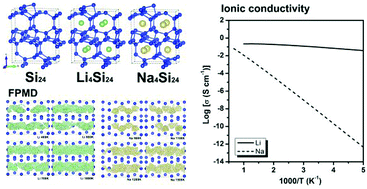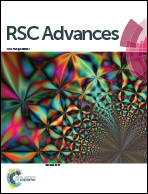A first-principles study on Si24 as an anode material for rechargeable batteries†
Abstract
Due to its intriguing geometry, possessing an open-channel structure, Si24 demonstrates potential for storing and/or transporting Li/Na ions in rechargeable batteries. In this work, first-principles calculations were employed to investigate the phase stability and Li/Na storage and transport properties of the Si24 anode to evaluate its electrochemical performance for batteries. The intercalation of Li and Na into the Si24 structure could deliver a capacity of 159 mA h g−1 (Li4Si24 and Na4Si24), and the average intercalation potentials were 0.17 V (vs. Li) and 0.34 V (vs. Na). Moreover, the volume change of Si24 upon intercalation proved very small (0.09% for Li, 2.81% for Na), indicating its “zero-strain” properties with stable cycling performance. Li+ and Na+ can diffuse along the channels inside the Si24 structure with barrier energies of 0.14 and 0.80 eV respectively, and the ionic conductivity of Li2.66Si24 was calculated to be as high as 1.03 × 10−1 S cm−1 at 300 K. Our calculations indicate that the fast Li-ionic conductivity properties make the Si24 structure a novel anode material for both lithium and sodium ion batteries.



 Please wait while we load your content...
Please wait while we load your content...